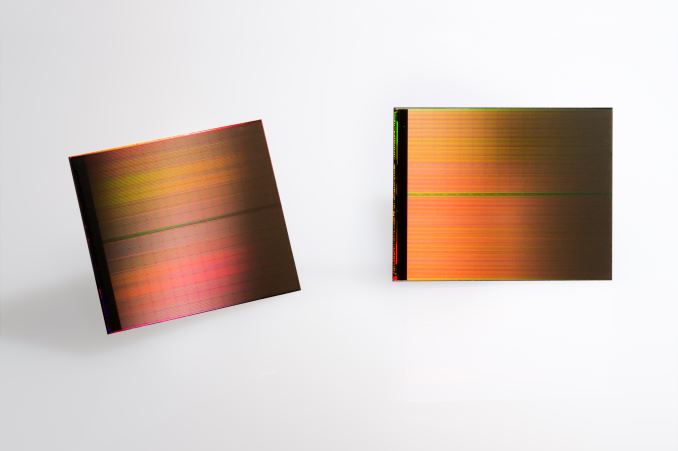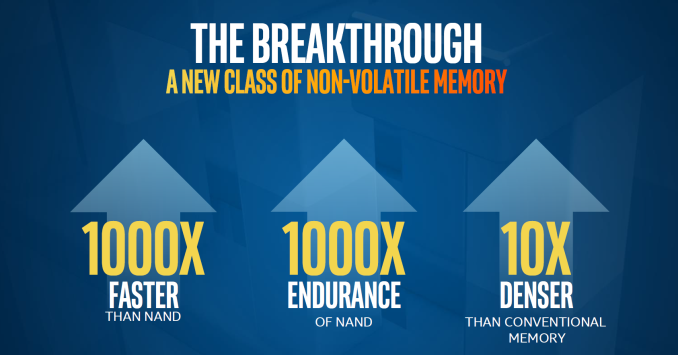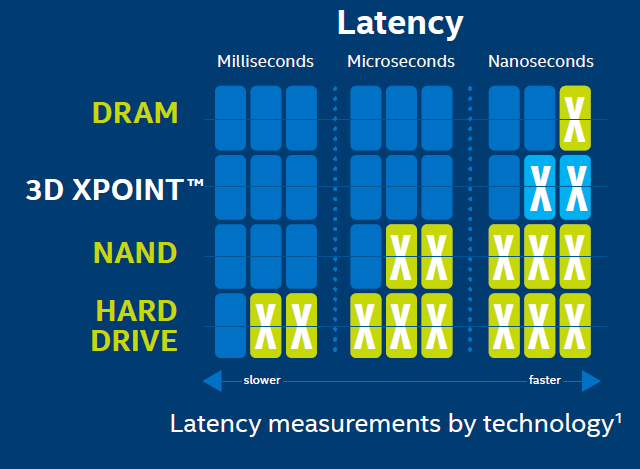Analyzing Intel-Micron 3D XPoint: The Next Generation Non-Volatile Memory
by Kristian Vättö, Ian Cutress & Ryan Smith on July 31, 2015 11:00 AM EST
The current mainstream memory technologies, namely DRAM (quick memory accessed by the processor) and NAND (solid-state storage), have been around for decades. While the cell designs have evolved over the years to allow scaling to 20nm and below, the fundamental physics behind DRAM and NAND operation haven't changed a bit and both technologies have their unique technological limitations. DRAM offers nanosecond-level latency and unlimited endurance, but this comes at the cost of large cell size, cell volatility, and power consumption. Since DRAM cells need to be constantly refreshed, the cells don't retain data in an off state, requiring quite a bit of power and making DRAM unsuitable for permanent storage. NAND, on the other hand, has much higher latency (especially write operations) and has a limited number of write cycles, but the cells are non-volatile and the structure is much more efficient, enabling low cost and suitability for storage.
Combining DRAM and NAND at the system-level architecture provides the best of both worlds, which is why modern computers use DRAM as a memory/cache and NAND for storage. However, there's still a latency and capacity gap between DRAM and NAND, so the question arises: what if you were to combine the best of DRAM and NAND at the silicon level? The mission of next generation memory technology across the industry has been to develop a new type of memory that provides low latency and high endurance while offering a small and scalable cell size.
We have seen numerous startups, such as Crossbar and Nantero, discuss and demonstrate their next generation memory technologies, but we have yet to see the established DRAM and NAND vendors come out with their solutions. Intel and Micron are here to change that with the announcement of their new 3D XPoint (Cross Point) non-volatile memory technology this week.
First and foremost, Intel and Micron are making it clear that they are not positioning 3D XPoint as a replacement technology for either NAND or DRAM, and in that scale it has been talked about more in its applications nearer NAND than DRAM. It's supposed to complement both and provide a technology that sits in between the two by filling the latency and cost gap exists between DRAM and NAND. Basically, 3D XPoint is a new tier in the computer architecture because it can be used as either slower, non-volitile memory or much faster storage.
| DRAM | 3D XPoint | NAND | |
| Endurance (P/E Cycles) | 10^15 | 10^7 | 10^3 |
| Read Latency | Nanoseconds | 10s of Nanoseconds | ~100 Microseconds |
Intel and Micron are claiming that 3D XPoint provides up to a thousand times higher endurance than NAND. Assuming that the numbers are relative to modern (15-20nm) MLC NAND, the endurance should be in the order of a few million P/E cycles; though the marketing materials are claiming up to tens of millions of write cycles. If we assume 3 million write cycles (1000x of what modern MLC has), a 256GB 3D XPoint based drive would have a total write endurance of 768 petabytes. That's equivalent to 420TB per day for five years, or 4.9GB per second. For storage applications that currently rely on NAND, 3D XPoint will eliminate any potential endurance concerns, but it's not durable enough to challenge DRAM in that front since DRAM endurance is essentially infinite. Whether 3D XPoint provides enough endurance to replace DRAM ultimately depends on the application, but especially in certain enterprise workloads there's a need for DRAM.
3D XPoint latency should be in the order of 10s of nanoseconds, but the companies didn't specify whether this is read or write latency. Judging by the graphs provided by Intel, it seems to be read latency because NAND write latency would measured in milliseconds (typically 1-2ms for a full page write), whereas the graph puts NAND latency at tens of microseconds that is in line with NAND read latency. Write latency is likely higher than that, probably at least 100s of nanoseconds or even a few microseconds given Intel and Micron's claims of "up to 1000x faster than NAND", but what complicates things is that 3D XPoint is accessible at the bit-level whereas NAND is page-level, so comparing the latency of the two without extended context is quite difficult. In any case, 3D XPoint performance should be closer to DRAM than NAND, but since Intel and Micron aren't discussing any specific latencies yet it's too early to make any final conclusions.
Meanwhile unlike many next generation memory technologies out there at the moment, 3D XPoint is the furthest along and doesn't only exist on paper or in a lab. Intel and Micron are currently sampling the first generation die that is being produced at the companies' jointly owned fab in Lehi, Utah. The die is 128Gbit (16GB) in capacity, whereas the products that startup memory companies have in production are in the order of dozens of megabytes. The die is built on a 20nm node and consists of two layers, and in the future scaling will happen through both lithography shrinks and by increasing the number of layers.
The Utah fab has been producing 20nm NAND for now since Intel didn't invest on the 16nm shrink and all initial 3D NAND production will take place in Micron's Singapore fab, but it's unclear whether the full fab with its 20,000 wafers per month capacity will be dedicated to 3D XPoint from now on. My guess would be that 3D XPoint will gradually take over the full wafer capacity in Utah depending on how the market reacts to the new technology and how high demand Intel and Micron are seeing. 3D XPoint does require some new equipment for manufacturing since 3D XPoint deals with a whole new set of materials, but Intel and Micron said that the transition is quite similar to a new NAND node and allows some of the existing equipment to be used.
The companies aren't quoting any price per gigabyte yet, but since the whole function of 3D XPoint is to fill the gap between DRAM and NAND, it will also be priced accordingly. A quick look at NewEgg puts DRAM pricing at approximately $5-6 per gigabyte, whereas the high-end enterprise SSDs are in the range of $2-3. While client SSDs can be had for as low as $0.35, they aren't really a fair comparison because at least initially 3D XPoint will be aimed for enterprise applications. My educated guess is that the first 3D XPoint based products will be priced at about $4 per gigabyte, possibly even slightly lower depending on how DRAM and NAND pricess fall within a year.












80 Comments
View All Comments
wishgranter - Saturday, August 1, 2015 - link
As always, waited for Anand to tear it to the point and explain it as they did it,this is stuff that differ you from other "news" sites... So let see what they bring to market...
azazel1024 - Saturday, August 1, 2015 - link
Great, so now I need to get a boot drive again.DRAM, XPOINT boot drive, SSD application drive and HDD bulk storage. Maybe we can usher in holographic storage and have another tier! I mostly kid, but man getting excessive. It would be cool if this was added in through new/advanced memory controllers and utilize the DRAM slots. If the price is at least reasonably less than DRAM (by at least a factor of 2), I can see uses. A legit OS drive space. Useful for higher end tablets and stuff with embedded high speed storage. A serious swap disk, etc.
16GB of RAM with 32-64GB of XPOINT and then the SSD/HDD storage systems would probably make a pretty wicked system. Use the XPOINT to do things like load large parts of games/applications in a super fast swap disk pre-loading as much as possible and then quickly import the parts in to RAM that are needed instead of slower imports from SSD/HDD to RAM.
A little disappointed that this doesn't sound like it'll be remotely economical to compete with NAND anytime soon. I had my hopes up with the density claims and what not that we might have a NAND replacement at HDD price per GB in a couple of years.
userDavid - Saturday, August 1, 2015 - link
"SPoint" is my guess for pronunciation. If the marketing idiots can't spell out "3D CrossPoint", I don't think we're obliged to pronounce it that way.jay401 - Saturday, August 1, 2015 - link
"A quick look at NewEgg puts DRAM pricing at approximately $5-6 per gigabyte, whereas the high-end enterprise SSDs are in the range of $2-3. While client SSDs can be had for as low as $0.35, they aren't really a fair comparison because at least initially 3D XPoint will be aimed for enterprise applications. My educated guess is that the first 3D XPoint based products will be priced at about $4 per gigabyte, possibly even slightly lower depending on how DRAM and NAND pricess fall within a year."Oh, okay, see you in five years or so, when this technology becomes relevant to the consumer. @___@
Crazy1 - Saturday, August 1, 2015 - link
I hate that Intel and Micron didn't talk about potential uses for this new technology. Letting my imagination run wild, I'm thinking small, battery powered embedded solutions is a good starting point. Basically IoT devices, from infrastructure sensors on up to smart watches. There are not many market standards in place in this category of computing devices and energy efficiency is more important than high performance. This XPoint tech could replace both NAND and DRAM in these devices, presumably increasing energy efficiency. It also provides small, adaptable platforms for developers to start programming for applications with no RAM.I don't see XPoint replacing DRAM and NAND in smartphones and tablets any time soon. I assume it will take a while before OSes and apps can adapt to a no RAM environment. It will take a few SoC generations for this tech to have hardware support as well (unless they were already in-the-know). Smaller issues include degraded performance in RAM heavy applications (i.e. graphics processing) and increased hardware costs. The GPU might need its own RAM buffer (might I suggest HBM), further increasing implementation costs. Also, encrypted storage gets a little costly, from an energy perspective, when that storage bandwidth is very fast. Ideally, there will be a hardware encryption accelerator in the mix (and the OS will implement it (looking at you Android)).
However, there are a lot of potential benefits to replacing RAM and NAND completely with XPoint from a smart phone. The device could turn on and off almost instantly. Power management would not need to deal with the energy costs of shuffling around large amounts of data to enter and exit a sleep state. OSes and apps would be smaller and more efficient due to significantly reduced memory management concerns (some minimal wear leveling and ECC).
The first implementation of XPoint in smartphones/tablets will probably be as an added cache to accelerate the NAND and act as a swap partition. The NAND eMMC in most smart phones is more competitive with a modern HDD than a SSD when it comes to transfer speeds, so the NAND could definitely use a boost.
The day XPoint replaces NAND SSD's in the consumer space will be glorious. If speculation on price is correct, it may be a while before even the average enthusiast can rationalize the expense. However, I did see an Intel video that described DRAM as expensive and both XPoint and NAND as inexpensive. So, it would stand to reason that XPoint would be closer to the price of NAND than DRAM once initial market shock has subsided a bit and production has ramped up. However, Intel is rarely known to offer inexpensive products compared to its competition, so the real hope is that Micron pushes this technology at a price and quantity that stimulates quick market adoption.
Brane2 - Saturday, August 1, 2015 - link
How the heck can you "analyze" something that you know practically nothing about ?All you have is a bit of marketing fluff and you are building virtual castles out of that....
Laststop311 - Saturday, August 1, 2015 - link
maybe bias is affecting me but it seems the quality of articles has gone down since this site was sold and anand left.Kristian Vättö - Monday, August 3, 2015 - link
Could you elaborate? I think this article in particular is far more in-depth than any of the other articles I've read on the topic and it really goes into great detail about the physics side as well.speculatrix - Sunday, August 2, 2015 - link
typo "either slower, non-volitile memory" - volAtileVetri33 - Sunday, August 2, 2015 - link
There is NO mention of the error rate in 3D Xpoint compare to Enterprise NAND!?. This may make a big difference in Enterprise SSD Controller architecture & implementation like whether LDPC, BCH or a very simple Error Correction algorithm is good enough!?. The power is an another big factor especially in Write, One of the main limiting factor in enterprise SSD write performance is the power budget.